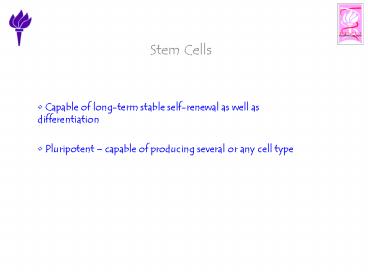Capable of longterm stable selfrenewal as well as differentiation PowerPoint PPT Presentation
1 / 30
Title: Capable of longterm stable selfrenewal as well as differentiation
1
Stem Cells
- Capable of long-term stable self-renewal as well
as differentiation - Pluripotent capable of producing several or
any cell type
2
Interest in Stem Cell Research
- Animal cloning
- Possible source of cells for cell-based
therapies for many human diseases - Possible therapeutic cloning, whereby ES cells
could be derived from a patients cells, thus
avoiding problems of immune rejection, and then
coaxed into forming large quantities of the cell
types needed for a cure.
3
Fundamental Questions in Stem Cell Research
- What defines stem cells in molecular terms?
- What signaling events control stem cell
self-renewal and differentiation? - What does it mean to reprogram a cell?
- What is the role of stem cells in tumors?
4
The First Discoveries About Stem Cells
- Production of teratocarcinoma with pluripotent
and self-renewing properties. Leroy C. Stevens,
Developmental Biology 21, 364-382 (1970) - Establishment in culture of pluripotential
embryonic stem cells (ES). M. J. Evans and M. M.
Kaufman, Nature 292, 9 July (1981) - Implantation of stem cells into X-irradiated
mice. P. Hollands, Development 99, 69-76 (1987).
5
The First Discoveries About Stem Cells
6
The First Discoveries About Stem Cells
7
The First Discoveries About Stem Cells
- Long-lived (immortal) and stable
- Capable of very wide differentiation patterns
- Able as single cells to colonize vast areas of
chimaeras - Capable of repairing tissues in sick recipients
- Persisting in vivo throughout lifespan
- Partially free of host-versus-graft or
graft-versus-host reactions
8
Stem Cells in Adult Organisms
- Stem cells in adult through asymmetric
divisions, adult stem cells produce just the
right number of differentiated cells, as well as
daughter stem cells with properties identical to
those from which they arose. This is true
self-renewal. - ES in the embryo although many cells undergo a
similar asymmetric division with respect to
daughter cell fate, this does not necessarily
involve exact self-renewal. The daughter stem
cells progressively become restricted in the
variety of differentiated progeny they can
produce, thereby losing developmental potential.
9
Stem Cells in Adult Organisms
10
Hematopoietic Lineage
11
Each Stage of Differentiation Involves
Functionally Irreversible Maturation Steps
12
Turning Blood Into Brain
Christopher R. R. Bjornson, Rodney L. Rietze,
Brent A. Reynolds, M. Cristina Magli, Angelo
L. Vescovi Science, 283, 22 January 1999.
13
Turning Blood Into Brain
Christopher R. R. Bjornson, Rodney L. Rietze,
Brent A. Reynolds, M. Cristina Magli, Angelo
L. Vescovi Science, 283, 22 January 1999.
14
Turning Blood Into Brain
Christopher R. R. Bjornson, Rodney L. Rietze,
Brent A. Reynolds, M. Cristina Magli, Angelo
L. Vescovi Science, 283, 22 January 1999.
15
Transplanting a Nucleus of Adult Cells into
Embryonic Cells
I. Wilmut, A. E. Schnieke, J. McWhir, A. J. Kind
and K. H. S. Campbel Nature 385, 27 February 1997
16
Transplanting a Nucleus of Adult Cells into
Embryonic Cells
I. Wilmut, A. E. Schnieke, J. McWhir, A. J. Kind
and K. H. S. Campbel Nature 385, 27 February 1997
17
- How do the stem cells know their identity?
- How are self-renewal and differentiation
controlled? - Specialized functions required to ensure proper
stem cell function are vested in neighboring
differentiated cells. - A niche is considered to be a subset of tissue
cells and extracellular substrates that can
indefinitely house one or more stem cells and
control their self-renewal and progeny production
in vivo
18
Niche
Lineage mechanism asymmetric division Population
mechanism symmetric division
19
Germ Cell Differentiation in Drosophila
Amy A. Kiger, Helen White-Cooper and Margaret T.
Fuller, Nature 407, 12 October 2000.
20
(No Transcript)
21
Mitosis
22
Yukiko M. Yamashita, D. Leanne Jones, Margaret T.
Fuller, Science 301, 12 September 2003.
23
Yukiko M. Yamashita, D. Leanne Jones, Margaret T.
Fuller, Science 301, 12 September 2003.
24
(No Transcript)
25
(No Transcript)
26
Wild Type vs Bcl-2 Transgenic Mice
Jon Domen, Samuel H. Cheshier, Irving L,
Weissman, J. Exp. Med. 191, n. 2, 17 January
2000.
27
Regulation of Stem Cell Population
28
Pathways in Cancer and Development
29
Kazutoshi Takahashi, Koru Mitsui, Shinya
Yamanaka, Nature 423, 29 May 2003
30
Kazutoshi Takahashi, Koru Mitsui, Shinya
Yamanaka, Nature 423, 29 May 2003

